|
|
||
|
|
| [diecast models] - [information] - [links] - [news] - [plastic models] - [resin models] - [trams] - [xtra] |
|
|
||
|
|
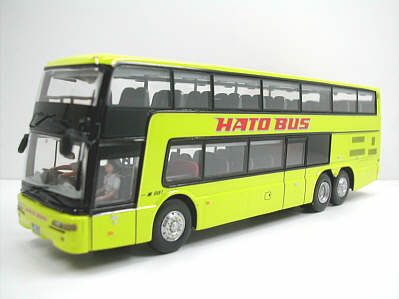 |
This model first appeared in Creative Master Northcord's 2004/05 product catalogue. In April 2005 Porte Publishing announced further details of the model and kindly provided a photograph of a pre-production example. The model, in the livery of Hato Bus, is due for release in Japan in June and is limited to 3,100 pieces.
Mitsubishi's 'Aero
King' was first exhibited
at a motor show in 1983 and entered production in 1985.
Press Release - 8 June 2005
NEW CASTING ---- JB4001 Mitsubishi Fuso Aero King ---- HATO BUS
Creative Master Northcord Limited has proudly released its first livery on the Mitsubishi Fuso Aero King double-decker coach replica, JB4001, in Hato Bus colours.
The Aero King is an exclusive double-decker bus / coach developed by Mitsubishi Motors Company, later Mitsubishi Fuso Truck and Bus Corporation, and available in the Japanese market. The Aero King bus features an aerodynamic body shape, front independent suspension, 12-metre 3-axle chassis design and it created history in the Japanese double-deck bus / coach making industry.
The replica features excellent detailing, inside and out, including 4 windscreen wipers, hand rails on the upper and lower decks, an opening engine door and engine detail. This is a one-piece casting whose clean lines accentuate the windows and livery application on which all logos and lettering are clearly legible. The model has no ugly metal poles to hold it together.
Hato Bus is one of the biggest tour bus operators in Japan. “Hato” is a Japanese name meaning “Phoenix”. Hato Bus operates around 70 regular sightseeing routes mainly in the Tokyo area with about 140 single-decker / double-decker coaches. Hato Bus acquired its first Japanese-made double-decker coach, Mitsubishi Fuso Aero King (MU612TA), in 1996.
JB4001 has an outstanding feature. There are two figures on board. They are the bus captain and the tour guide with unique Hato Bus uniforms. Both figures are well presented with detailed painting. They will create extra interest for collectors.
The Mitsubishi Fuso Aero King coach is the fourth 1/76 scale diecast bus or coach replica for the Japanese market from Creative Master Northcord since 2000. It is also the first double-decker, following the Mitsubishi FUSO MP Non-step Bus, Hino Selega Coach and Mitsubishi Fuso Aerobus Coach.
The JB4001 model is limited to 500 pieces for the UK and Hong Kong. They will be distributed by John Ayrey Die-Casts Limited (UK) and Concorde Hobby Shop (HK) respectively.
Creative Master
Northcord Limited (CMNL)
------The World’s Miniature Bus
Co.
The Packaging
The model comes in the now standard Club Busrama style outer cardboard box with chequered ends. A brief description of Hato Bus operations is featured in both Japanese (I assume it is Japanese!) and English on the back of the box together with a colour photograph of the real coach.
The model sits on a standard black plastic base with a clear plastic display case over it. Creative Master Northcord Ltd (CMNL) have used their unique ‘no screws’ approach, the base having three lugs that protrude into the underside of the model.
The base of the model features some chassis detailing. Impregnated onto the base are the words ‘Club Busrama Porte Publishing’ and ‘Fuso Aero King 1:76 precision scaled Creative Master’.
The Casting
The model features a single piece casting, with no poles holding it together, although the lower front panel is a separate moulding and this probably aids in keeping the model together. It may also enable possible variations to the front end, if such exist. The rear bumper section is plastic and again presumably aids in keeping the model together. The leading rear axle carries twin wheels whilst the rearmost axle is single wheeled.
The Exterior
The paintwork is to a very high standard, as you would expect from a CMNL model and is not too heavily applied so as to lose any of the contour lines of the bus. Side repeater indicators lamps are picked out in orange, the handles to the side luggage compartments in silver. Grilles to the rear engine compartment are tampo printed as are the rear light clusters. The headlamp details are extremely realistic, however I am unsure of their construction! The actual headlamps are clearly visible behind lenses along with the orange coloured indicator lamps. The lower driving lamps are recessed into the front panel, being cast and highlighted in silver. The wheelnuts on the silver coloured wheels are all picked out in yellow. The only minor criticism I have is that the high level rear emergency exit door is not cast into the model, being represented by tampo printing only. Pairs of finely detailed windscreen wipers are fitted to both lower and upper deck windscreens. The drivers external rear view mirror is of a standard design whilst the nearside mirror, or mirrors to be precise, feature a rather more intricate arrangement.
Hato Bus fleetnames are applied between decks, between the front headlamp units and on the opening rear engine cover. The Hato Bus logo is featured on the roof. Registration plates and legal lettering are all tampo printed and are all crisp and clear. The number 681 is featured just ahead of both front wheel arches and again on the sides at the rear. I assume this is a fleet number.
The small rear engine cover opens to reveal engine details. When in the closed position, it gives the impression that it does not open, so precise is the fit.
The Interior
CMNL, in their press release for this model, regard the inclusion of a driver (sorry Bus Captain!) and tour guide as an outstanding feature. Although this is a nice touch, what would be an outstanding feature would be to fill the coach with passengers as well! Both driver and guide are well presented with the male driver wearing a white shirt and green coloured tie and the female guide wearing a smart hat, a white top with bows and a dark coloured skirt
Interior detailing is again superb, featuring a driver’s internal rear view mirror, steering wheel, dash mounted equipment which includes a cctv monitor, upper deck front grab rails, upper-deck overhead ventilation controls and a lower-deck toilet compartment. The upper-deck has seating for 42 passengers whilst the lower has seating for 12.
Verdict
The model is typical to CMNL – superb quality and meticulous attention to detail. Save for my minor criticism of the rear emergency exit door, as mentioned above, this is an excellent representation of this unusual vehicle to those of us living outside of Japan. Well worth getting the first example of this new casting.
Graham
White
11th June 2005
| Manufacturer of model | Creative Master Northcord Ltd | |
| Scale | 1:76 | |
| Prototype chassis | Mitsubishi Fuso Aero King | |
| Prototype bodywork | Mitsubishi | |
| Prototype length | 12 metre | |
| Fleet number | ? | |
| Registration number | 55-21 | |
| Route number | - | |
| Destination | - | |
| Commissioned by | Club Busrama | |
| Quantity (total) | 3,100 | |
|
|
Japan | |
| Quantities (if known) |
|
|
| Date released |
|
|
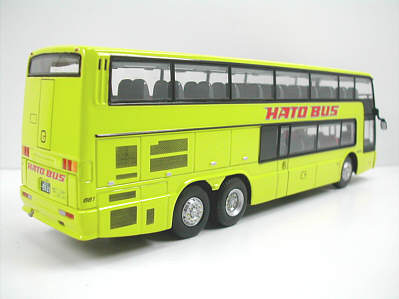 |
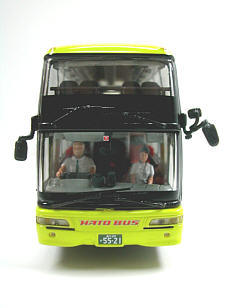 |
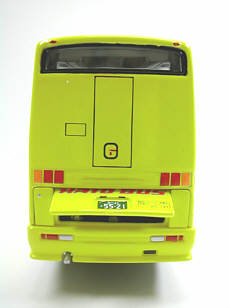 |
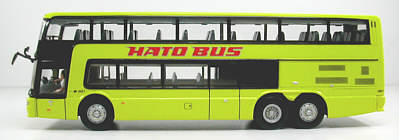 |
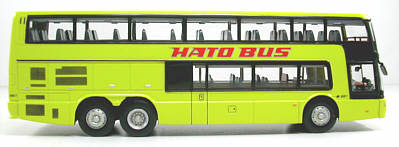 |
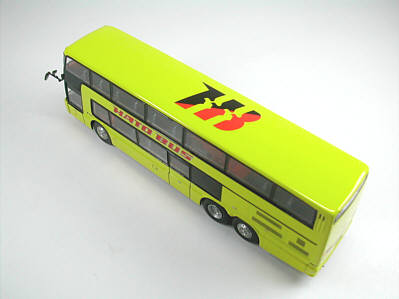 |
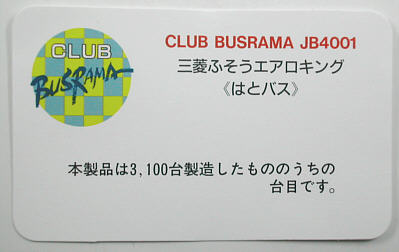 |
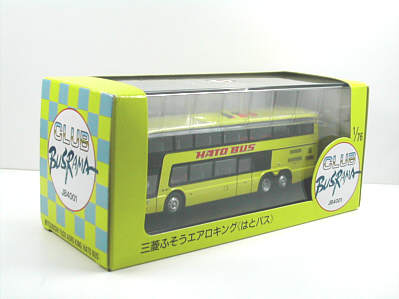 |
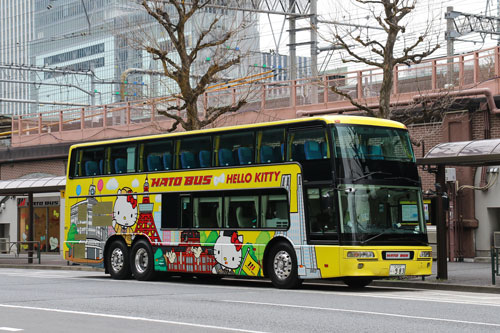 |
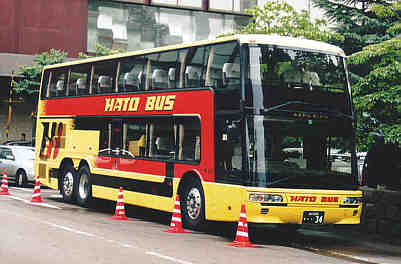 |
|
|
|||
|
|||
|
|
|||
|
|
|||
|
|
|||